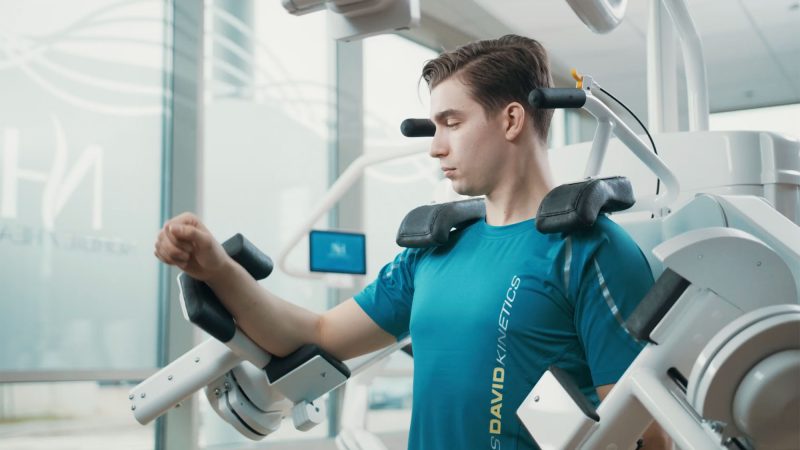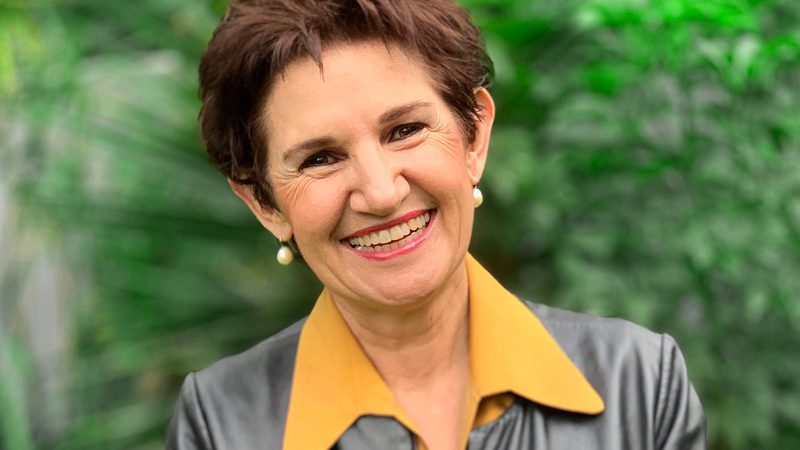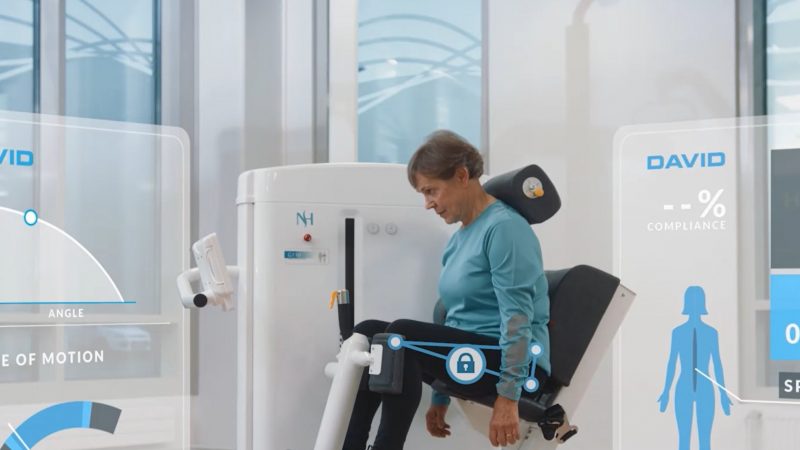1. Triage
Given the current uncertainty regarding COVID-19 contagiousness and the importance of the safety of the physiotherapist, patient, and their environments, triaging of patients is important. We recommend to triage patients according to the national guidelines in health care for people with COVID-19.
- The principles of ‘social distancing’ (1.5 meters distance or e-health) should be considered and adhered to as much as possible for physiotherapy sessions
- If the patient has been tested positive for COVID-19 and/or has symptoms consistent with COVID-19 symptoms in the 14 days prior to triage, the physiotherapist should use personal protective equipment (surgical face mask (type IIR), glasses or face shield, and disposable gloves) It is essential that the physiotherapist is familiar with their national guidelines on safety, infection control, and transmission prevention and recommended organization of physiotherapy services. These may indicate the need for specific infection risk assessment, physical distancing, and personal protective equipment.
| Infection risk and safety for the physiotherapist and patient |
| • The principles of ‘social distancing’ (1.5 meters distance or e-health) should be considered and adhered to as much as possible for physiotherapy sessions |
| • If the patient has been tested positive for COVID-19 and/or has symptoms consistent with COVID-19 symptoms in the 14 days prior to triage, the physiotherapist should use personal protective equipment (surgical face mask (type IIR), glasses or face shield and disposable gloves) |
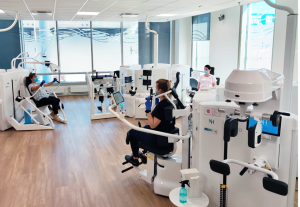
2. Limitations in functioning and indication for physiotherapy
Patients who have been severely or critically ill and/or have been hospitalized (for a prolonged time) may have (severe) limitations in physical, emotional, cognitive, and/ or social functioning. Physiotherapy can play an important role in the rehabilitation of these patients and focuses mainly on limitations in physical functioning. It is important that the physiotherapist is aware of and identifies other potential limitations that the patient may experience. In these cases, intra- or interdisciplinary collaboration may be required.
Not all patients with COVID-19 will have an indication for physiotherapy. Only Version 2.0 / 27 July 2020 11 Dutch KNGF position statement: Recommendations for physiotherapy in patients with COVID-19 patients with a request for guidance and presenting with limitations in physical functioning, e.g. activities of daily living, physical activity or exercise capacity, are eligible for physiotherapy. Intra- and/or interdisciplinary collaboration is important for patients with a complex clinical situation and the need for health care services. Patients with multiple and severe problems (physical, mental, cognitive, and/or social) may benefit from other health care providers during their rehabilitation. In these patients, physiotherapy as a sole health care service is not sufficient.
| Functional limitations and indication for physiotherapy |
| • Patients with a request for guidance and limitations in physical functioning have an indication for physiotherapy.
• In complex cases, such as post-ICU patients with severe limitation and/or comorbidities, intra- and interdisciplinary collaboration is required. |
3. Recommendations for physiotherapy
The patient’s personal needs and requests for guidance as well as their perceived limitations in physical functioning are always the main focus of physiotherapy. There is still little known about the course of recovery, physical capacity to load, and physical limitations in patients who have had an active COVID-19 infection. Patients planned to be discharged from the hospital will not undergo an exercise test around the time of discharge, which normally provides an indication of lung and/or heart function. Therefore, there is a lack of clinical information on the patient’s physical function and exercise capability. Hence, the physiotherapist has no specific clinical information to determine parameters for exercise prescription.
Globally, the organization of healthcare and clinical follow-up may be considerably different. In some countries, such as the Netherlands, most patients who have been hospitalized receive a medical follow-up in the hospital after approximately six weeks of discharge. During the follow-up appointment physical functions (including lung and/or heart function) can be tested and physical activity and performance levels can be assessed. Based on these test results, the physiotherapist can determine more adequately the patient’s exercise capacity and how to gradually increase their physical activity levels (using exercise prescription principles: frequency, intensity, time/duration, and type). Patients who have experienced COVID-19 at home have not had and will not have tests in the hospital. With a lack of information, their exercise capacity and tolerance levels remain more uncertain.
| Physiotherapy treatment |
| • The patient’s personal needs and request for guidance and the perceived limitations in physical functioning are the main focus of physiotherapy.
• There is still little known about the course of recovery, the physical capacity to load and physical limitations in patients who have had an active COVID-19 infection. Therefore, caution is needed when assessing and treating these patients. • Based on time after illness and experienced physical abilities the clinical recommendations are divided into two main sections: the first six weeks after hospital discharge or illness at home, and the period after these six weeks |
4. The first six weeks after hospital discharge / or illness from COVID-19 at home
Patients who are discharged from the hospital often receive advice to gradually increase their activities of daily living and are given functional physical exercises to perform at home. When there is an indication for physiotherapy at discharge, it is expected that patients will receive transfer information from the hospital. In some cases, patients will be contacted by telephone by (the physiotherapist of) the hospital after approximately two weeks. The aim of this consultation is to assess the progress of these patients’ daily functioning after discharge. When the patient still has (severe) limitations in their daily physical functioning there is an indication for physiotherapy. The hospital may refer the patient to a physiotherapist who can provide physiotherapy care to the patient in their home environment.
When the patient still has severe limitations in their daily physical functioning there is an indication for physiotherapy.
However, the follow-up and organization of assessment may differ per hospital, region, and country. If a patient has been admitted to a hospital, but there is no transfer, the physiotherapist is recommended to contact (the physiotherapy department of) the hospital for further information. Patients who were ill from COVID-19 at home will often have been and/or be in contact with their general practitioner (GP). This may also apply to patients who have been discharged from the hospital and transferred to the GP for medical follow-up. The GP can consult with and inform a physiotherapist if deemed necessary. Patients, their relatives or other caregivers can also contact the physiotherapist directly. This group is expected to be small given the coordinating role of medical health care service providers, i.e. hospitals and GPs. In case of direct access to physiotherapy, it is strongly recommended to contact the patient’s GP prior to the commencement of treatment. Interdisciplinary communication and collaboration are of great importance in the delivery of adequate health care services.
5. First consultation and indication for physiotherapy
Within two weeks after hospital discharge or after symptoms of active COVID-19 infection have subsided the physiotherapist contacts the patient, in case referral from the hospital or GP was received or in case of direct access. The aim of this first contact is to understand how the patient is feeling and what possible (physical) limitations the patient is experiencing – in all the domains of the World Health Organisation’s International Classification of Functioning, Disability, and Health (WHO-ICF) model. The physiotherapist should preferably use remote communication, such as telephone contact or video calling, as much as possible. Besides, recording existing and newly acquired comorbidities prior to or from Version 2.0 / 27 July 2020 13 KNGF position statement: Recommendations for physiotherapy in patients with COVID-19 COVID-19 including possibly affected organs, such as lungs and/or heart, is essential to be able to assess the patient’s current health status.
When the patient is referred from a hospital or by a GP, such information is expected to be described in a transferal/referral note. Based on the obtained information from health care providers and the patient, the physiotherapist assesses the severity of limitations in the patient’s physical functioning using all the domains of the WHO-ICF model. Together with the patient’s specific needs and request for guidance, the physiotherapist decides whether there is an indication for physiotherapy.
Patients who have been admitted to the ICU may have ICU-acquired weakness (ICUAW) and/or may experience Post Intensive Care Syndrome (PICS). These patients may experience severe physical deconditioning and malnutrition, with physical, mental, and/or cognitive impairment. The capacity to exercise and perform (daily) activities are very low in these patients and the risk to overload is high. In these patients, it is highly recommended to refer them (via the GP) to a rehabilitation center. When the patient experiences functional limitations and/or limitations in activities and/or participation in daily life and has a request for guidance, physiotherapy is indicated.
| First consultation |
| • Within the first two weeks after hospital discharge or after symptoms of active COVID-19 infection have subsided, contact the patient by telephone or video calling to assess the perceived limitations in physical functioning and determine whether there is an indication for physiotherapy.
• Patients with a request for guidance and limitations in physical functioning have an indication for physiotherapy. • Be aware of existing or newly acquired comorbidities. |
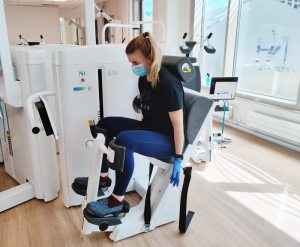
6. Red and yellow flags
Screening for red flags prior to further assessment and treatment in COVID-19 patients is very important. From some red flags, when present, the assessment or treatment must be temporarily discontinued. For other red flags, the physiotherapist should consult with the GP or other referring doctor.
| Red flags |
| Discontinue the assessment/treatment and consult a doctor in case of:
• Heart frequency in rest is 130 beats per minute • Respiratory rate of >40 per minute • Oxygen saturation in rest of ≤90% and/or during exercise/activity of <85% • Heart arrhythmia • Painful and swollen limbs (suspicion of deep vein thrombosis) • Acute dyspnea (due to suspicion of pulmonary embolism) • Recent myocardial ischemia • Excessive sweating, facial cues of feeling unwell (incl color), anxiety
|
| Discontinue the assessment/treatment and repeat measurements at a later stage in case of: |
| • Fever (core temperature >38.0° Celsius) • Exhaustion (Borg Scale score for fatigue ≥5 out of 10 while resting) • High blood pressure while resting (≥180/100 mmHg |
Yellow flags are also important to take into account during assessment and treatment sessions. Yellow flags are factors that may negatively influence recovery. The physiotherapist is advised to carefully screen for factors that may require the involvement of other health professionals, such as the GP, psychologist, social work, occupational therapist, dietician, or specialized physiotherapists (e.g. psychosomatic physiotherapist). See Appendix 1 for advice on yellow flags. Black flags are also included in Appendix 1.
| Yellow flags |
| • Dysfunctional breathing
• Delirium in recent medical history* • Fear of physical activity/exercise • Fear for shortness of breath • Sleeping problems • Post-traumatic stress syndrome** • External locus of control • Negative beliefs and/or concerns about symptoms * Almost 100% of patients with COVID-19 waking at ICU have delirium. |
7. Clinical outcome measures for the first six weeks
It is important to identify factors that can influence recovery and/or can guide clinical decision making. The WHO-ICF can serve as a model to capture and organize several constructs from the subjective and objective assessment. Clinical outcome measures are used to assess and evaluate the functioning of patients, guide clinical decision making, and optimize treatment. The core set of clinical outcome measures for the first six weeks after hospital discharge or illness from COVID-19 at home consists of:
- Patient-Specific Functioning Scale (PSFS) to determine the perceived physical limitations in participation and activities of daily living.
- Borg Scale CR10 for Shortness of Breath and Fatigue indicating shortness of breath and fatigue experienced by the patient. A maximum threshold score for exercise intensity of 4 out of 10 on the Borg Scale CR10 applies at this time after illness.
- Oxygen saturation (SpO2 ) at rest, during and after physical activity, and therapeutic exercise. If the physiotherapist has a pulse oximeter, it can be delivered to the patient’s home, when treatment is provided remotely.
- Heart rate (HR) at rest, during and after physical activity, and therapeutic exercise. In the case of e-health consultation, heart rate can be measured by instructing the patient on how to measure it himself, for example using the Version 2.0 / 27 July 2020 15 KNGF position statement: Recommendations for physiotherapy in patients with a COVID-19 pulse oximeter or by instructing the patient how to measure it themselves with the heart rate indicated by the patient (‘counting strokes aloud’). The physiotherapist should be aware that outcomes can be influenced by medication.
- Short Physical Performance Battery (SPPB) to measure balance, muscle strength, and mobility. The SPPB consists of a balance test, walking speed over 4 meters and 5 times repeated standing up from a chair test. The physiotherapist must at all times ensure the safety of the patient if they are (seriously) weakened. In the case of e-health consultation, the SPPB cannot be performed.
- Grip Strength to estimate overall peripheral muscle strength. If possible and available, a hand-held dynamometer is used.
- 6-Minute Walk Test (6MWT) to estimate exercise capacity. In the case of e-health consultation or the patient has (very) low exercise tolerance levels, the 6MWT should not be attempted.
- Short Nutritional Assessment Questionnaire (SNAQ65+) for early detection of malnutrition in patients who have been hospitalized. The physiotherapist uses the SNAQ65+ to identify a potential malnutrition status of the patient. A dietician should be consulted or referred to in case of signs of malnutrition. It is important that the physiotherapist and dietician have good communication and collaboration.
In this position statement, the clinical outcome measures focus on physical functioning. Optionally, during the first six weeks, a pedometer/accelerometer can be used to determine and monitor daily physical activity levels. Also, one-repetition maximum (1RM) tests can be used to determine muscle strength of specific muscle groups and to determine initial intensities of exercises that improve muscle strength (Table 1).
| Construct | Patient with (very) low exercise tolerance levels* | Patient with increased exercise tolerance levels* |
| Activities and participation in ADL | PSFS | PSK |
| Perceived fatigue | Borg Scale CR10 for Shortness of Breath and Fatigue | Borg Scale CR10 for Shortness of Breath and Fatigue |
| Perceived breathlessness (dyspnea) | Borg Scale CR10 for Shortness of Breath and Fatigue | Borg Scale CR10 for Shortness of Breath and Fatigue |
| Oxygen saturation | transcutaneous oxygen saturation (SpO2 ) | transcutaneous oxygen saturation (SpO2 ) |
| Heart rate | Heart rate measurement | Heart rate measurement |
| Muscle strength lower extremity | SPPB; repeated stand up from chair test (5x) | SPPB; repeated stand up from chair test (5x), 1 RMδ |
| Muscle strength upper extremity | Grip strength | Grip strength, 1 RMδ |
| Balance | SPPB; balance test | SPPB; balance test |
| Mobility | SPPB; 4-meter timed walk test | SPPB; 4-meter timed walk test |
| Physical activity level | pedometer/accelerometerδ | pedometer/accelerometerδ |
| Exercise capacity | – | 6MWT |
| Nutritional status | SNAQ65+ | SNAQ65+ |
Besides physiotherapy specific assessment and treatment, the physiotherapist plays an important role in identifying factors that may limit (the speed of) recovery, in particular in case the patient is not also monitored by the GP or hospital. Factors to be aware of include nutritional status, cognitive and emotional functioning, and psychosocial functioning.
A multidisciplinary approach may be necessary when such factors are present. The decision on specific clinical outcome measures also depends on collaboration with other healthcare disciplines. The use of different clinical outcomes for the same constructs by different healthcare professionals should be avoided to facilitate interdisciplinary communication and monitoring of the patient, and not burden the patient unnecessarily.
| A core set of clinical outcome measures for the ‘first six weeks’ |
| • Use the Patient-Specific Functioning Scale to identify perceived limitations in activities of daily living.
• Use the Borg Scale CR10 to monitor shortness of breath and fatigue. • Before, during, and after physical activity and exercises, monitor the patient’s oxygen saturation and heart rate. • Use the Short Physical Performance Battery (SPPB) to measure balance, muscle strength, and mobility. • Use grip strength measurements (handheld dynamometer) to estimate overall peripheral muscle strength. • Use, when safe, 6-minutes walk test (6MWT) to estimate the exercise capacity. • Use the Short Nutritional Assessment Questionnaire (SNAQ65+) for early identification of potential malnutrition in patients who have been hospitalized. |
This position statement has been developed by the Royal Dutch Society for Physical Therapy (KNGF) together with a national working group of experts in the field of physiotherapy, from a patient association (Longfonds) and the Dutch Lung Association (Long Alliantie Nederland). This position statement describes recommendations regarding physiotherapy services for patients with confirmed or suspected COVID-19 after hospital discharge or patients who have been ill at home. Recommendations in this position statement are based on international evidence and guidelines on COVID-19, expert opinion, and patient preferences.
References
- Zhou F, Yu T, Du R, Fan G, Liu Y, Liu Z, et al. Clinical course and risk factors for mortality of adult inpatients with COVID-19 in Wuhan, China: a retrospective cohort study. Lancet. 2020;395(10229):1054-62.
- Phelan AL, Katz R, Gostin LO. The novel coronavirus originating in Wuhan, China: Challenges for global health governance. JAMA – J Am Med Assoc. 2020;323(8):709-10.
- National Institute for Public Health and the Environment (RIVM). [Verspreiding nieuw coronavirus (COVID-19)] [in Dutch]. 24 July 2020. Available via: https:// www.rivm.nl/ coronavirus/covid-19/verspreiding.
- National Institute for Public Health and the Environment (RIVM). [Actuele informatie over het nieuwe coronavirus (COVID-19)]. [Internet]. [in Dutch]. 24 July 2020. Available via: https:// rivm.nl/coronavirus-covid-19/actueel.
- National Institute for Public Health and the Environment (RIVM). [Coronavirussen] [Internet]. [in Dutch]. 24 July 2020. Available via: https://www.rivm.nl/ coronavirus.
- Letko M, Marzi A, Munster V. Functional assessment of cell entry and receptor usage for SARS-CoV-2 and other lineage B betacoronaviruses. Nat Microbiol [Internet].2020;5(4):562-9.
- Sohrabi C, Alsafi Z, O’Neill N, Khan M, Kerwan A, Al-Jabir A, et al. World Health Organization declares global emergency: A review of the 2019 novel coronavirus (COVID-19). Int J Surg [Internet]. 2020;76(February):71-6.
- National Institute for Public Health and the Environment (RIVM). [Het virus (SARCCoV-2)] [Internet]. [in Dutch]. 24 July 2020. Available via: https://www.rivm.nl/ coronaviruscovid-19/virus.
- National Institute for Public Health and the Environment (RIVM). [De ziekte COVID-19] [Internet]. [in Dutch]. 24 July 2020. Available via: https://www.rivm.nl/ coronaviruscovid-19/ziekte
- Chang D, Mo G, Yuan X, Tao Y, Peng X, Wang F, et al. Time kinetics of viral clearance and resolution of symptoms in novel coronavirus infection. Am J Respir Crit Care Med. 2020;201(9):1150-2.
- Moore KA, Lipsitch M, Barry JM, Osterholm MT. COVID-19: The CIDRAP Viewpoint; Part 1: The future of the COVID-19 pandemic: Lessons learned from pandemic infl uenza [Internet]. April 2020. Available via: cidrap.umn.edu.
- Remuzzi A, Remuzzi G. COVID-19 and Italy: what next? Lancet [Internet]. 2020;395(10231):1225-8.
- Wu Z, McGoogan JM. Characteristics of and important lessons from the coronavirus disease 2019 (COVID-19) outbreak in China: summary of a report of 72314 cases from the Chinese center for disease control and prevention. JAMA – J Am Med Assoc. 2020;323(13):1239-42.
- Tingbo L. Handbook of COVID-19 prevention and treatment [Internet]. Handbook of Covid-19, prevention and treatment. 2020. p. 68. Available via: https:// covid-19.alibabacloud.com.
- Livingston E, Bucher K, Rekito A. Coronavirus disease 2019 and infl uenza 20192020. JAMA – J Am Med Assoc. 2020;323(12):1122.
- Felten-Barentsz KM, van Oorsouw R, Klooster E, Koenders N, Driehuis F; Hulzebos EHJ, et al. Recommendations for hospital-based physical therapy treatment of patients with COVID-19. Phys Ther J. June 2020.
- Terpos E, Ntanasis-Stathopoulos I, Elalamy I, Kastritis E, Sergentanis TN, Politou M, et al. Hematological findings and complications of COVID-19. Am J Hematol. 2020;1-14
- Poissy J, Goutay J, Caplan M, Parmentier E, Duburcq T, Lassalle F, et al. Pulmonary Embolism in COVID-19 Patients: Awareness of an Increased Prevalence. Circulation. 2020;1–6.
- Li YC, Bai WZ, Hashikawa T. The neuroinvasive potential of SARS-CoV2 may play a role in the respiratory failure of COVID-19 patients. J Med Virol. 2020;92(6):552–5.
- Needham DM, Davidson J, Cohen H, Hopkins RO, Weinert C, Wunsch H, et al. Improving long-term outcomes after discharge from intensive care unit: Report from a stakeholders’ conference. Crit Care Med. 2012;40(2):502-9.
- Vitacca M, Mauro Carone, Enrico Clini, Paneroni M, Lazzeri M, Lanza A, et al. Joint statement on the role of respiratory rehabilitation in the COVID-19 crisis : the Italian position paper. AIPO Ric Ed – Milano. 2020;1-17.
- Ad-hoc Taskforce European Respiratory Society (ERS), version April 3rd 2020, Available via: https://www.ersnet.org/covid-19-blog/covid-19-and-rehabilitation
- Driehuis F, Meerhoff G, Vreeken H, Swart H, van Doormaal M, Post M. [KNGFrichtlijnenmethodiek 2019: Ontwikkeling en implementatie van KNGF-richtlijnen] [in Dutch] Royal Dutch Society for Physical Therapy (KNGF), Amersfoort, 2019. Available via: https://www.kngf.nl/kennisplatform/guidelines
- Dutch Association for Medical Specialists (FMS). [Leidraad Nazorg bij ICpatiënten met COVID-19, 10 april 2020] [in Dutch]. Available via https://www. demedischspecialist.nl/ sites/default/fi les/Standpunt%20Nazorg%20COVID19.pdf.
- Dutch Association for Medical Specialists (FMS). [Leidraad Nazorg bij patiënten met COVID-19, 28 mei 2020] [ in Dutch]. Available via: https://www. demedischspecialist.nl/ sites/default/files/Leidraad%20Nazorg%20COVID-19.pdf.
- International Classification of Functioning, Disability and Health. Genève, Zwitserland: WHO; 2001.
- Dutch Association of Rehabilitation physicians (VRA), [Advies basisset klinimetrie nazorgpoli, versie 30 april 2020], [in Dutch]. Available via: https:// revalidatiegeneeskunde. nl/coronavirus-en-revalidatie-sector.
- Royal Dutch Society of Physical Therapy (KNGF). KNGF-guidline COPD [in Dutch], KNGF Amersfoort. Available via: https://www.kngf.nl/kennisplatform/richtlijnen/ copd-2020
- Bisselt B, Gosselink R, van Haren FMP, Respiratory muscle rehabilitation in patients with prolonged mechanical ventilation: a targeted approach. Crit Care. 2020;24:103.
- Laveneziana P, Albuquerque A, Aliverti A, Babb T, Barreiro E, Dres M, et al. ERS Statement on respirator muscle testing at rest and during exercise. Eur Resp Journal, 2019;53
- Cooper BG, An update on contraindications for lung function testing. BMJ Thorax. 2011;66:714-23.
- Mitchell, L. Simple Relaxation – The physiological method for easing tension, 1977, John Murray, London
- Jacobson, E. Progressive Relaxation, 1939, University of Chicago Press.
- Royal Dutch Society for Physical Therapy (KNGF), KNGF position statement: Recommendations for physiotherapy in patients with COVID-19, July 2020, Amersfoort, the Netherlands
 Deutsch
Deutsch 






















